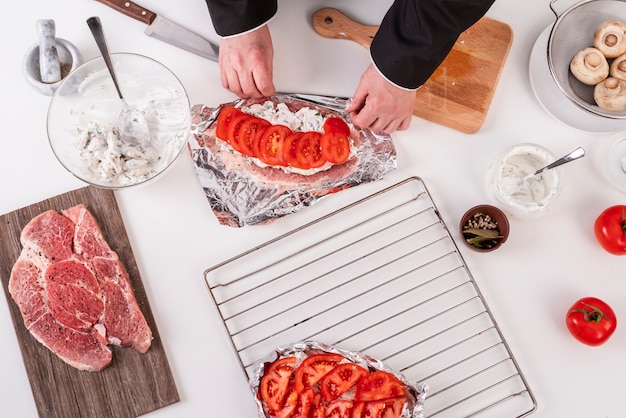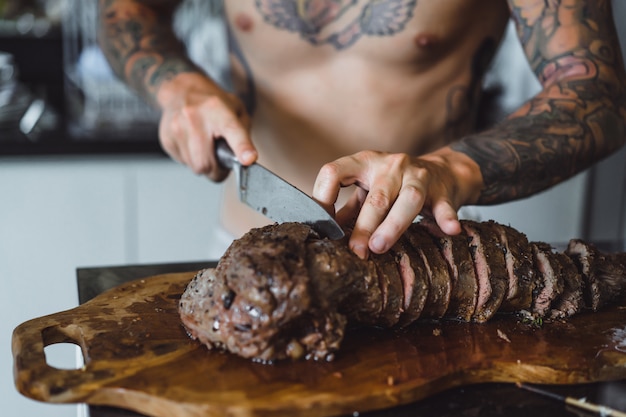You've got a beautiful new york strip steak, ready to be transformed into a culinary masterpiece. But before you even think about firing up the grill or cranking the oven, let's talk about cooking time. This isn't a "throw it on the heat and see what happens" situation. We're talking about precision, about understanding how heat affects a steak and turning it from raw to perfectly cooked. And believe me, that's something I've learned a lot about over the years.
I've been obsessed with grilling and cooking for years. I've tried countless techniques, experimented with different cuts of meat, and yes, I've had my fair share of mishaps (burnt edges anyone?). But through those experiences, I've learned a thing or two. This guide is about demystifying the world of New York steak cooking time, giving you the knowledge and confidence to cook a steak that's juicy, tender, and utterly delicious.
(Part 1) The Star of the Show: Your New York strip steak

Before we dive into cooking times, let's get to know our star: the new york strip steak. This cut is known for its rich marbling and flavorful character, making it a true classic. But every steak is unique, and factors like thickness, marbling, and even the initial temperature of your steak can impact cooking time.
Thickness: A Key Factor
The first thing to consider is the thickness of your steak. A 1-inch thick steak will cook much faster than a 2-inch thick steak. It's a pretty obvious concept, but crucial to factor in when planning your cooking time. You don't want to overcook a thinner steak or undercook a thicker one, and the difference can be significant.
Marbling: A Flavor Booster
Next, let's talk about marbling. This refers to the fat dispersed throughout the meat, a crucial element for both flavor and tenderness. A steak with lots of marbling will cook more evenly and retain its juiciness, while a leaner steak might need a bit more attention and careful timing to avoid dryness.
Temperature Matters: Room Temperature is Key
Finally, remember the initial temperature of your steak. If you pull it straight from the fridge, it's going to take longer to reach your desired internal temperature. That's why it's always a good idea to let your steak sit at room temperature for about 30 minutes before cooking. This allows it to come closer to room temperature, ensuring more even cooking.
(Part 2) Navigating the Doneness Levels

Now, let's talk about the doneness levels. You've probably heard the terms "rare," "medium-rare," "medium," and "well-done." But what do they actually mean, and how do you know when your steak is cooked to your liking? Let's break it down.
Rare: A Hint of Pink
Rare is the most undercooked level, characterized by a bright red center and a cool touch. It's for those who prefer a steak with a hint of pink and a tender, juicy texture. The internal temperature for rare is between 125°F (52°C) and 130°F (54°C).
Medium-Rare: The Perfect Balance
Medium-rare is a popular choice, offering a balance of flavor and tenderness. It's known for its pink center and a slightly warmer touch. The internal temperature for medium-rare is between 130°F (54°C) and 135°F (57°C).
Medium: The Middle Ground
Medium offers a more cooked option, with a pink center that's starting to turn a bit grey. It's a good middle ground between rare and well-done. The internal temperature for medium is between 135°F (57°C) and 140°F (60°C).
Well-Done: Cooked Through and Through
Well-done is the most cooked level, with a grey-brown center and a firm texture. It's for those who prefer their steak cooked through and through. The internal temperature for well-done is above 160°F (71°C).
(Part 3) Choosing Your Cooking Method

Okay, you've got your steak, you've decided on your desired doneness level, now it's time to choose your cooking method. Each method has its own strengths and quirks, so choosing the right one is key to achieving your perfect steak.
Grilling: The Classic
For me, grilling is the way to go. Nothing beats that smoky, chargrilled flavor. But mastering the grill requires a bit of practice. You need to make sure your grill is hot enough, and you need to keep a close eye on your steak to prevent burning. But don't worry, I'll guide you through it.
Oven: For Consistency and Control
The oven is a great option for those who prefer consistent results and more control. It allows you to cook the steak evenly without the risk of burning. Plus, you can cook multiple steaks at once, perfect for a crowd.
Pan-Searing: Quick and Easy
Pan-searing is the quickest and easiest method. It creates a flavorful crust and cooks the steak evenly. But it's important to use a good quality pan and heat it up properly, or your steak will stick.
(Part 4) Timing is Everything: Cooking Time Guides
Now we're getting to the heart of the matter: the actual cooking time. While there's no magic formula, I've developed some helpful guidelines based on my experience. Remember, these are just guides, and the actual cooking time will vary depending on the thickness of your steak, the heat of your grill or oven, and your desired doneness.
Grilling Time Chart
For a 1-inch thick New York strip steak, here's a rough guideline for grilling times:
| Doneness | Grilling Time (per side) |
|---|---|
| Rare | 2-3 minutes |
| Medium-Rare | 3-4 minutes |
| Medium | 4-5 minutes |
| Well-Done | 5-6 minutes |
oven cooking time Chart
For a 1-inch thick New York strip steak, here's a rough guideline for oven cooking times:
| Doneness | Oven Time |
|---|---|
| Rare | 10-12 minutes |
| Medium-Rare | 12-15 minutes |
| Medium | 15-18 minutes |
| Well-Done | 18-20 minutes |
Remember to preheat your oven to 400°F (204°C) before putting the steak in.
Pan-Searing Time Chart
For a 1-inch thick New York strip steak, here's a rough guideline for pan-searing times:
| Doneness | Pan-Searing Time (per side) |
|---|---|
| Rare | 2-3 minutes |
| Medium-Rare | 3-4 minutes |
| Medium | 4-5 minutes |
| Well-Done | 5-6 minutes |
Remember to heat your pan over medium-high heat before adding the steak.
(Part 5) Temperature Matters: The Importance of a meat thermometer
Some people rely on eyeballing the color of the steak to determine doneness. But I'm a firm believer in using a meat thermometer. It's the most accurate way to ensure your steak is cooked to perfection.
Remember, you're not aiming for a visual cue, you're aiming for a specific internal temperature. A thermometer takes the guesswork out of cooking, helping you avoid overcooking, which can lead to dryness and a tough texture.
There are many types of meat thermometers available, but I recommend a digital instant-read thermometer. It's quick, easy to use, and very accurate.
(Part 6) Resting: Let It Relax for Perfect Results
You've cooked your steak to your desired doneness, but don't dive right in! This is where the resting period comes in. Resting your steak for 5-10 minutes allows the juices to redistribute throughout the meat, resulting in a more tender and flavorful steak. It's a small step, but it makes a big difference.
While your steak rests, you can prepare the rest of your meal. Whip up some mashed potatoes, sauté some vegetables, or even make a simple salad. This will give you time to relax and let the aromas fill the kitchen.
(Part 7) Seasoning: The Finishing Touch
Now, let's get to the finishing touches. No New York steak is complete without the perfect seasoning. I love to keep things simple with just a little salt and pepper, but feel free to experiment with other herbs and spices. You can also use a pre-made steak seasoning blend, but make sure it's not overpowering.
The key is to season generously and evenly, coating the entire surface of the steak. This will help to create a flavorful crust and lock in the juices during cooking.
(Part 8) Serving Your Masterpiece
Finally, it's time to serve your masterpiece. Slice the steak against the grain to create tender, juicy pieces. Arrange it on a plate with your chosen sides and enjoy!
(Part 9) FAQs: Your Steak Cooking Questions Answered
You've got questions, I've got answers. Let's tackle some common queries about New York steak cooking.
Q1: How do I know if my grill is hot enough?
Hold your hand a few inches above the grill grates. If you can't hold your hand there for more than 2-3 seconds, it's hot enough.
Q2: What should I do if my steak is sticking to the pan?
Don't panic! Just use a spatula to gently loosen the steak. If it's still stuck, try adding a little bit of oil to the pan.
Q3: Can I cook my steak in the microwave?
I wouldn't recommend it. Microwaving a steak can lead to an unevenly cooked, rubbery texture. Stick to the traditional methods, you'll be happier in the long run.
Q4: What if I overcook my steak?
Don't despair! It's not the end of the world. If you've overcooked your steak, it will be tough and dry. Try slicing it thinly and adding a flavorful sauce to help compensate.
Q5: What are some good side dishes for New York steak?
There are endless possibilities! I love to pair my steak with creamy mashed potatoes, roasted vegetables, a simple salad, or even a baked potato loaded with cheese and bacon.
So, there you have it, my comprehensive guide to cooking a perfect New York steak. Whether you're a seasoned grilling pro or a kitchen newbie, this guide should help you achieve steak nirvana. Don't be afraid to experiment, try different methods, and find what works best for you. Happy grilling!
Everyone is watching

How to Cook Frozen Lobster Tails Perfectly: A Step-by-Step Guide
RecipesLobster. Just the word conjures up images of lavish meals, special occasions, and a taste of luxury. But let's...

Pigs in a Blanket Cooking Time: How Long to Bake for Perfect Results
RecipesAh, pigs in a blanket. Just the name conjures up images of those delightful little parcels of crispy pastry en...

Pork Fillet Cooking Time: How Long to Cook It Perfectly
RecipesPork fillet, or tenderloin as it's sometimes called, is a real favourite in our house. It's so versatile, and...

The Ultimate Guide to Cooking Delicious Frankfurters
RecipesLet's face it, we all love a good frankfurter. It's a classic, simple, and always satisfying. But let's be rea...

Wolf Meat Recipes: A Guide to Cooking Wild Game
RecipesLet's be honest, you don't see wolf meat at your local butcher shop every day. It's a bit of a wild card, but ...
